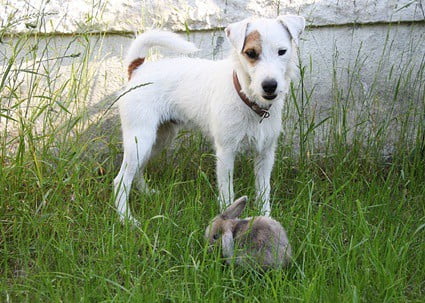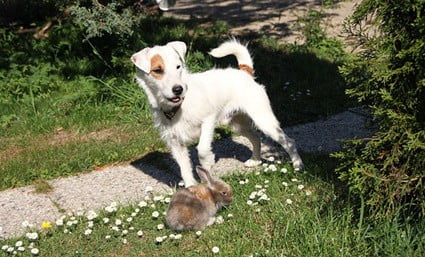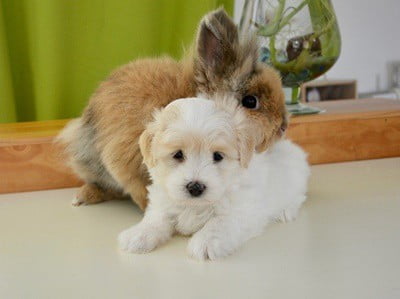Before adding a new pet to your family, it’s important to consider how the animal will get along with your existing pets. For example, you may wonder if your dog will get along with a new bunny. Likewise, you may expect conflict between your long-time rabbit companion and an excitable new puppy. One is obviously a prey animal and the other a predator.
Domestic rabbits and dogs can live together. However, this requires bonding the two animals through consistent exposure in a safe environment. This will train your canine to resist its hunting instincts when around the rabbit. If possible, you should also choose a dog with a low prey drive. Even after training, you will still need to constantly supervise your dog when it roams free with a rabbit.
By selecting the right dog, you can lessen the chances of it lapsing in its training. The most important step will be creating a firm bond between the two animals. This will make your rabbit less prone to fleeing and your dog less prone to hunting.
Do Dogs And Rabbits Get Along?
Rabbits and dogs are not evolutionarily designed to be friends. Their natural instinct is to fear and hunt each other. If left to their own devices, you will find a very real case of “my dog killed my pet rabbit.”
This is usually spurred by a dog’s prey drive. That’s the instinct of canines to chase down their prey. It is the driving force behind most aggressive dogs.
In practice, it’s usually seen when your rabbit is startled into running. When confronted with a small, fleeing animal, a dog’s natural instincts will be to pursue. Even if it felt no compulsion to harm the rabbit otherwise, it won’t be able to resist. The situation will then escalate until the rabbit has been caught and harmed, or worse.
With that said, a dog and rabbit can get along in the right conditions. The key is lessening those predator-prey instincts whenever possible. This can be helped by choosing the right breed of dog, with the right personality.
No matter the dog you own (or hope to own), the most important step is bonding. By creating a bond between the dog and the rabbit, you can better ensure the safety of both animals.

Can Rabbits Bond with Dogs?
It is possible for rabbits to bond with dogs. This should be done carefully, however. Keep these three things in mind before you begin:
Focus Training on The Dog
Rabbits cannot fight back against dogs. Even if they could, they cannot be trained to the level that dogs can. After all, dogs have been human companions since prehistoric times. If there’s one animal that will listen to you, it is your dog, not your rabbit.
Get An Adult Dog
While a puppy is easier to train, an adult dog will often have a calmer temperament. Puppies will be more boisterous, loud, and more active before they grow older.
This behavior will startle your rabbit into fleeing. Once it does, the hunt begins, which can make the bonding process dangerous.
If you’re buying or adopting a dog, for the sake of your rabbit, consider choosing an adult. If you already have a puppy, you can still bond it with a bunny. Just understand that you’ll need far more patience and supervision.
Prior Training for The Dog
Dogs should already be well-socialized and able to pick up on basic commands. It should acknowledge your position as the alpha in the pack. Commands like ‘sit,’ ‘stay,’ and ‘no’ will be invaluable when bonding a dog and rabbit.
If your adult dog or puppy lacks this training, you should wait on bonding. Keep your rabbit separate from the dog until it’s undergone and accepted some training.
How To Bond Rabbits And Dogs
The purpose of bonding rabbits with dogs teaches the dog that your rabbit is part of the pack. Once a dog learns this, it will;
- Be more prone to guarding the rabbit than hunting it
- Understand that a rabbit is not a toy
- Be encouraged to uphold certain trained behaviors around the rabbit. Without this, the dog might revert as soon as you’re not looking.
When bonding a rabbit and a dog, always do so one-on-one.
Introduce The Animals Through a Cage
Place your rabbit inside its hutch. Then, allow your dog to investigate the rabbit through the bars. Expect there to be some sniffing between the two.
Do not put your dog on a leash. When leashed, dogs can become too excitable. Instead, allow the dog to investigate on its own terms, in a casual environment.
At this stage, do not allow your dog to bark or whine. The idea is to establish restraint and patience in your dog. This can take a few repetitions, over the span of many days. Eventually, your dog should realize that its best behavior is needed when a rabbit is around.
Let Your Rabbit Roam
Start by sitting on the floor near the cage. Then, tell your dog to lie flat on its side, with the head on the floor as well. This is a submissive position.
This will teach your dog that, in the pack, it is not an alpha over the rabbit. It will also make your dog less threatening in the eyes of your rabbit.
Open your rabbit’s cage and allow it to roam. Do not physically move the rabbit out. It should leave so voluntarily. Allow your rabbit to be comfortable around your dog, whether or not it actually wants to interact.
Continue Socialization
Repeat the above step once a day for at least two weeks. Watch your dog closely for any lapses in its training, such as nipping, barking, or jumping at the rabbit. This behavior should be corrected. If it happens often, return to Step 1 and work back up.
When a dog feels the rabbit is more relaxed, it will want to play with the rabbit. This isn’t safe. Instead, make sure that your dog keeps quiet, with its head down. Praise your dog whenever it maintains this behavior.
Keep in mind it’s not mandatory for the animals to engage each other. The goal is to have both of them feel calm while the other is around.
Have Your Rabbit And Dog Bonded?
Your rabbit and dog have bonded when they are at ease with each other. This will look different from one pair to another. For some bonded pets, they will show indifference. Other pairs will be so bonded that they sleep beside each other. While that’s great to achieve, certain pets will never reach this level of bonding.
Whether or not your animals snuggle up together doesn’t matter. What’s important is that both animals respect each other’s boundaries. Dogs should always assume a calm and submissive position whenever a rabbit is around. A bonded rabbit should not flee from the sight of your dog.
Never leave a dog and rabbit roaming around in the house without supervision. Even the best training and the most thorough bonding can leave room for accidents. For the safety of both pets, only let them interact under your careful eye, where you can intervene if necessary.
Best Dog Breeds for Pet Rabbits
Temperament plays a huge role in how your pets will interact. For example, you may have the calmest and most docile dog.
However, it will take a courageous rabbit to approach an animal that’s larger than it. Unfortunately, you can’t predict the personality of your new pet. To circumvent that, you have to choose a dog based on its pedigree.
You’ll be hard-pressed to find a rabbit with a low survival instinct. In contrast, dogs have been bred for centuries to have different prey instincts. Certain dog breeds are more likely to get along with your rabbit.
In fact, Acta Veterinaria emphasized the differences in behaviors according to breeds. In this study, scientists calculated hunting ability, playfulness, and aggression, and determined how it linked to a dog’s breed.
Are Golden Retrievers Good with Rabbits?
Golden Retrievers are known as gentle, docile animals. They’re one of the most popular dog breeds in the United States. Overall, they’re beloved for a loyal nature and easy-to-train mentality.
The Golden Retriever is often affectionate and careful. When it comes to children and small animals, the Golden Retriever is perhaps the top of the list. Unlike most dogs, they are unbothered by quick movements, like that of a rabbit running past.
Instead, the Golden Retriever will gladly keep its cool, choosing to cooperate instead of unnecessarily stressing out other pets. Since rabbits are prone to sudden bursts of energy, this behavior can be invaluable. Retrievers tend to befriend other animals no matter the size, species, or temperament.
Around a well-trained and calm Retriever, a rabbit’s only concern will be the dog’s size. Because they are large, Golden Retrievers can knock over smaller animals by accident. However, alert rabbits can quickly dash out of the way.
In this regard, however, a dog should never be left unsupervised when roaming freely with a rabbit. Not even one as docile as a Golden Retriever.
Do Poodles Get Along with Rabbits?
On the other end of the spectrum are poodles. This breed is known for being high-strung, anxiety-prone, and having sharp, piercing barks.
Poodles are regarded as one of the smartest dog breeds. Their intelligence can be seen in the high level of activity this dog engages in. Paired with an air of mischief, this smart dog is often up to something. The Poodle is always down for a game, the more complex the better, and quality time with the people it loves.
However, because of its fancy appearance, this dog often doesn’t get the exercise it needs. Poodles tend to be untrained and spoiled. Paired with their high levels of energy, Poodles are anxious and loud.
Poodles are fiercely loyal, but they take a while to warm up to strangers. This extends to other animals in the house. When it comes to small animals, like rabbits, it’s best to stick to the toy Poodle. This is the smallest kind of Poodle and will lessen the chances of accidental injury to your rabbit.
Trained Poodles will take time to warm up to your rabbit. But when it does, your Poodle can become a loyal companion for your other pets.
Do Maltese Get Along with Rabbits?
A small dog can be far less intimidating to rabbits. As one of the smallest dog breeds, the Maltese comes in under 8 pounds, and averages at less than 5. It is considered a toy breed.
Maltese dogs have a calm personality. While not the friendliest dog breed to other animals, it is often too laidback to chase and hunt. Likewise, it is easygoing and highly intelligent. This intelligence can be easily seen during playtime, training, and other high-energy activities.
The only downside to Maltese dogs is their bark. They are vocal dogs, prone to snapping at objects that catch their attention. When they lack playtime, attention, and engagement, this barking can become a nuisance to everyone in the household.
This behavior can become a problem for rabbits, who are easily startled. However, there are some rabbits who do not mind loud noises. Of course, deaf rabbits will not have a problem with this behavior either.
Because of their barking, there are a large number of Maltese abandoned in shelters. In fact, they are considered to be the most abandoned dog breed in both Australia and Seoul, South Korea. You are likely to find many Maltese dogs in a shelter near you, just waiting for a loving home.

Do Great Pyrenees Get Along with Rabbits?
Great Pyrenees were bred to be livestock guard dogs. As such, they’re meant to work and spend most of their time with prey animals. This gives them an extremely low prey drive.
Unlike most of the canines on this list, Great Pyrenees are big dogs. On average, they weigh 100 pounds. Females reach a height of 25 to 30 inches, while males are between 27 to 32 inches. However, Great Pyrenees make up for this with their docile and calm personality.
The Great Pyrenees often exude an air of maturity. The breed is known to treat creatures smaller than it with sophisticated gentleness. However, this air of maturity comes with a streak of independence. This often manifests in loud barks.
The loud, almost rumbling bark will be an issue for rabbits. However, a Pyrenees is less likely to chase a fleeing animal that it has bonded with.
This breed is very prone to bonding with smaller animals. Your Pyrenees will quickly consider your rabbit as part of the pack. This will encourage it to protect your rabbit and approach the pet gently. Even after spooking it with a loud bark.
Do Old English Sheepdogs Get Along with Rabbits?
Herding dogs are often bred and trained to work with prey animals. As such, the Old English Sheepdog is a good rabbit companion.
This herding dog averages 21 inches in height and can weigh up to 100 pounds. It has a shaggy coat, often with its eyes hidden behind the fur. This coat makes the dog appear even larger than it is. However, the Old English Sheepdog makes up for its intimidating size in its playful, intelligent personality.
Family is important for dogs of this breed. This makes them prone to separation anxiety. However, with enough attention, this also makes the breed an excellent addition to any household. In fact, it’s known to have a bumbling personality, just to show affection to its family members.
This affection extends to prey animals like rabbits. As a livestock guard dog, this breed makes an excellent friend to smaller pets.
Compared to the Great Pyrenees, however, this breed is much quieter. This can be a great asset for easily spooked rabbits.
Do Labrador Retrievers Get Along with Rabbits?
Labradors were bred to be a work dog and a fisherman’s best friend. They can be trained to haul nets, fetch ropes, and retrieve fish. Their friendliness and hard-working nature makes them continue to be the most popular dog in America.
Labradors are just a tad smaller than others. They average about 23 inches in height, and weigh about 65 pounds. They have a muscular, athletic build. This build compliments their active and courageous personality.
Despite their large size, Labradors are considered one of the most sweet-natured breeds. They are playful, affectionate, and eager to please. They pair this wonderful personality with a high level of intelligence. That helps them serve as service dogs, search and rescue dogs, and therapy dogs.
One might think that a courageous dog will be aggressive towards prey. However, according to an article in the Journal of Animal Science, there’s very little correlation between courage and prey drive. After all, the Labrador pairs this courage with an intelligent mind. If you train your Lab right, it can become a great friend and loyal companion to your rabbit.
A rabbit’s safety should always be your number one priority. If you introduce a dog to the household, understand that there will always be some risk involved. However, with enough vigilance and hard work, it’s possible to have a dog and rabbit live in the same household.

